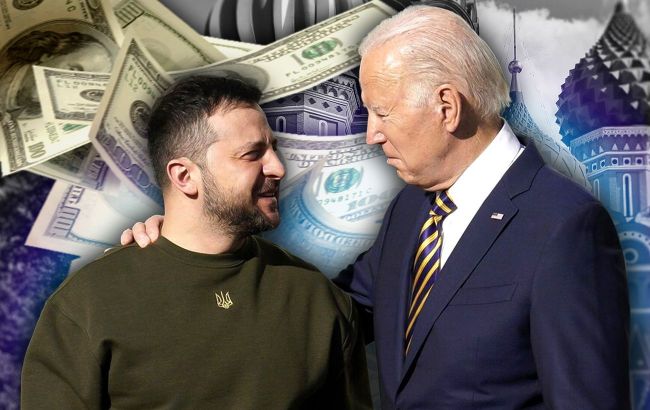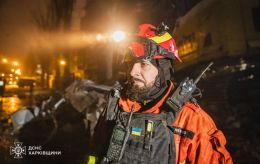Frozen Russian bllions. What's hindering reparation payments to Ukraine
 Likelihood of reparation payments to Ukraine is currently unlikely (collage: RBC-Ukraine)
Likelihood of reparation payments to Ukraine is currently unlikely (collage: RBC-Ukraine)
As of now, there is no significant prospect of Ukraine receiving reparations from frozen Russian assets. At best, Ukraine may only get income from these assets, amounting to up to $4 billion this year. RBC-Ukraine delves into the process of preparing compensation payments to Ukraine for the damage caused by the war and examines the obstacles along this path.
The article includes information from open sources, comments from Deputy Minister of Justice Iryna Mudra, and unofficial information from RBC-Ukraine sources.
Nearly half of Russia's foreign reserves have been frozen for almost two years in countries that have supported Ukraine in the conflict with Russia. Following Russia's full-scale invasion in February 2022, approximately $300 billion of the aggressor country's sovereign assets were blocked in the United States, the European Union, Canada, and subsequently in several other countries. This unofficial figure may be higher. According to open data analyzed by a financial analytics group, the total amount of Russia's sovereign assets in EU countries, the U.S., the UK, Japan, Canada, Australia, Singapore, and Switzerland could have exceeded $370 billion before the imposition of sanctions.
All frozen funds, after confiscation, are intended to be used for compensating Ukraine's losses. This idea is supported by Ukraine's partners, who are seeking a mechanism to confiscate and transfer these assets to Ukraine. There is little doubt even in Moscow that such a mechanism will be found, where, according to Reuters, they have already mentally parted with this money. "Deep down, everyone has already said goodbye to the reserves. There will certainly be (a legal process). It is a kind of ritual," quotes the outlet a source familiar with the Russian government's opinion.
However, confiscating and managing the money is not as straightforward as freezing it. A legal procedure is required to ensure that Russia cannot later claim the confiscation as unlawful. Yet, such a procedure does not currently exist, considering that there have been no precedents for reparations to be paid to countries before the end of a war. In financial matters, legal norms take precedence over moral norms. Therefore, in all countries where Russia's funds or sovereign bonds are located, every legal detail is being scrutinized.
Why reparations issue is actively discussed right now
The issue of using frozen Russian assets for payments in Ukraine began to be actively discussed at the end of last year. Importantly, the main messages did not come from Ukraine but from partner countries. Sources note that this topic became relevant when it became clear that financial assistance to Ukraine from the EU and the USA could be delayed. "We see that the amounts of funds we received in 2023 will be difficult to obtain now. Therefore, they (partners - ed.) would like to see confiscation as a mechanism to replace this funding. But how to legally confiscate funds, no one knows yet," said a source familiar with the course of negotiations on this issue to RBC-Ukraine.
The main part of the frozen reserves of the Russian central bank is located in the EU, particularly in Belgium. In Brussels, in the accounts of Euroclear (one of the largest depositories of securities), there are 180 billion euros (about 190 billion dollars). This figure is most often mentioned. As for the funds frozen in the USA, different data are mentioned. In 2022, the frozen amount was called 38 billion dollars, but according to the latest information, it is significantly smaller - about 8 billion dollars. As for Canada, the previously mentioned amount was 16 billion dollars, but according to updated information, the size of frozen assets is 1.3 billion dollars.

European Commission (Photo: Getty Images)
The exact data on frozen assets cannot be officially disclosed without a court decision. To find out the real situation, it is necessary to prepare a legal basis for the confiscation of funds and the payment of reparations. And then, in the process of legal procedures, the final amounts of arrested assets that can be paid to Ukraine will become known.
Legal basis for reparation payments
So far, reparations have been paid after wars in the form of goods and money, with goods being the predominant form of payment. There are several legal grounds for such payments.
The first is an international treaty. For instance, after World War I, the Treaty of Versailles was concluded, stipulating that Germany had to pay the Allied powers an amount equivalent to 100,000 tons of gold. These payments continued until 2010. After World War II, under the Potsdam Agreement, Germany paid reparations in the form of goods, with victorious countries extracting German goods and equipment from their occupation zones. However, this issue is not definitively closed - Poland's past government actively pursued reparations, with Warsaw's calculations reaching up to 1.3 trillion euros in claims against Germany. Germany insists that the reparation issue is definitively closed.
The second legal basis is a decision on reparations that can be made by an international organization with the authority to do so. In the case of Ukraine, this could be the UN General Assembly and Security Council, without requiring Russia's consent. A precedent already exists; Iraq paid reparations to Kuwait for the 1990 invasion through the UN Compensation Commission, established in 1991 and accountable to the UN Security Council.
In Iraq's case, the compensation fund was funded by a portion of oil and petroleum export revenues. Various embargoes on goods imported to and exported from Iraq were established, with occasional revisions. Iraq's assets were frozen in the United States, but since the amount was small and Iraq complied with all conditions, the freeze was lifted. This theoretical option could be applied to Russia as well, according to Ukraine's Deputy Minister of Justice, Iryna Mudra.
"We could have such an option (a source of compensation payments based on a set percentage of revenues from the sale of oil, petroleum products, gas - ed.) if Russia agreed to voluntarily fulfill the payment conditions. This option is also mentioned when discussing sources for filling the compensation fund for payments to victims and for the country's restoration (during discussions with partners - ed.)," Mudra stated.
However, since there is no judicial body that can compel Russia to pay reparations, a new legal mechanism for payments will have to be created. A relevant decision has already been adopted by the UN General Assembly on November 14, 2022. The resolution, Furtherance of remedy and reparation for aggression against Ukraine, was supported by 94 countries, opposed by 14, and 73 abstained.
According to this document, an international registry has been created within less than 8 months to collect all information about the damage inflicted on Ukraine and the victims. "From the second quarter of 2024, the registry is planned to be put into operation so that individuals, legal entities, and the state requiring reparations (Ukraine - ed.) can submit applications," Mudra noted.

Ukraine's Deputy Minister of Justice, Iryna Mudra (Photo: Facebook)
In this case, it is important to distinguish between the concepts of reparation and compensation. Reparation is paid to the state, and compensation to individuals and businesses is then derived from them. Thus, the registry does not yet determine the amounts of compensatory payments; a separate body, the compensation commission, must be established for this purpose. "In fact, it will be similar to the Iraq-Kuwait Compensation Commission. However, in that case, there was a decision by the UN Security Council, and in our case, because Russia will use the veto right (in 2023, Russia applied the veto right 35 times concerning 35 resolutions on Ukraine submitted to the Security Council), there will be an international multilateral agreement, which is currently being worked on," Mudra said.
This agreement should be signed by as many countries as possible. "These should include G7 countries, all countries that voted for the UN resolution, and where Russian assets are located. For the legitimacy of the instrument, as a new quasi-judicial body is being created, broad support is necessary. Asian, Latin American, and African countries need to be brought on board," said the Deputy Minister. After this, the treaty must be ratified by the parliaments of the signatory countries. Only then can the compensation commission determine the amounts for payment based on the registry, with Russian assets as the source.
Thus, expecting a quick resolution is not advisable. "According to my predictions, the commission should be established within a year plus some time for the agreements's ratification," noted the official.
Iryna Mudra did not rule out that if Russia agrees to voluntarily contribute to the fund for payments, as Iraq did in the past, part of its assets may be unfrozen. Otherwise, the transfer of blocked funds will be considered an advance payment to fulfill the obligations of the compensation commission's decision.
Currently, work is underway to gather information for the preparation of the international agreement and the adaptation of countries' legislation to initiate the reparation process. If a country is not ready for confiscation, another option is possible – the country's money (financial instruments, bonds, repurchased by that country) flows into the fund under the guarantee of assets frozen in its jurisdiction. "Essentially, this option means that the country finances Russia's debt and can then collect from it using the frozen funds," explained the official.

United Nations General Assembly (Photo: Getty Images)
Legislative decisions at the national level also play a role
Another option for transferring Russian money to Ukraine is being implemented in the United States. Two acts are under consideration, granting the president the power to confiscate assets solely by his decision. "It (the U.S.) is considering the use of 'countermeasures,' where the state can deviate from the obligation to protect sovereign assets if the owner has grossly violated international law," noted Mudra. If such norms are adopted, immunity from frozen assets will be lifted, and the funds can be directed to Ukraine.
One of the acts (Rebuilding Economic Prosperity and Opportunity (REPO) for Ukrainians Act) was already approved by the Senate Foreign Relations Committee on January 23. However, it still needs to be adopted by the full Senate and the House of Representatives, after which it will be sent to the President of the United States for signing.
In Canada, a law has already been passed allowing the transfer of frozen assets from Russia to Ukraine, but only after a court decision. Currently, there are plans to repeal the provision requiring a court decision in this law. As a result, the conditions for the confiscation of Russian assets in the United States and Canada will become similar. If other countries, especially EU members, make similar changes to their legislation, it will expedite the process of reparation payments. According to RBC-Ukraine's data, the Ukrainian side intends to negotiate with the EU on this matter.
Estonia has already decided on the possibility of transferring frozen Russian assets to Ukraine, even though there are no frozen funds from Russia in Estonia. This decision from Tallinn is seen as a gesture of support and solidarity with Ukraine.
Reparation receipts will go to the state budget and will be distributed from there according to needs. They may be used not only for compensation payments but also for debt repayment, with the government making the final decision.
Alternative to reparations and interest from Russian assets
Currently, there is no clear indication that reparations will be received soon. There are concerns in the European Union that the confiscation of Russian assets could provoke retaliatory actions from Russia. Even if payments begin in the current year, the initial amount is not expected to be substantial – around 9 billion euros at best, considering the contributions from the United States and Canada.
At the same time, for the second month, Ukraine has not received the planned funding from the EU and the US. This situation requires the exploration of alternative and additional sources of funding as quickly as possible.
One theoretical alternative to reparations is the issuance of reparation bonds. This idea was discussed at a recent economic forum in Davos. The concept involves Ukraine issuing bonds backed by frozen Russian assets. These bonds could be purchased by the US, EU governments, and other allies of Ukraine. The return of funds would only occur after Kyiv receives reparations. However, this mechanism is challenging to consider as ideal.

Volodymyr Zelenskyy and Ursula von der Leyen in Davos (Photo: Getty Images)
Firstly, no country has expressed readiness to buy such securities yet. Private investors are unlikely to be interested in the proposal due to the risks of non-repayment. The timeline for reparations payments and how Ukraine will service and settle its debts using these funds is also unclear.
Secondly, an additional issuance of bonds would significantly increase Ukraine's external debt, which already exceeds 50% of its GDP.
Thirdly, the proposal suggests paying interest on the bonds from the income generated by frozen assets. The question of whether Ukraine will receive this income has not been definitively resolved. Moreover, it seems unusual for Ukraine to allocate income from Russian assets, received as compensation, to servicing bond obligations. According to RBC-Ukraine, the idea of reparations bonds has not been supported by the Ukrainian government so far.
However, there is another instrument that could provide funding for Ukraine if reparation payments do not commence – the interest accrued on Russian assets. Currently, Russian assets are effectively blocked, but interest is accruing on them. Euroclear's income from frozen assets was $3 billion as of September last year, and this amount could increase to $4 billion. Theoretically, these funds could also be transferred to Ukraine. However, practical steps require a decision from EU member countries. Currently, this issue is under discussion, but a decision is not yet on the table.
According to a source familiar with the discussions in the EU, another option being considered is accumulating income from the redemption of securities in separate accounts and the possibility of receiving additional income from these funds, which could then be transferred to Ukraine. However, this raises legal questions about whether Euroclear can dispose of the income from frozen assets. Legal opinions on this matter are divided, according to the source.
Nevertheless, there is another option for using Russian reserves – the introduction of a tax on income from frozen assets. There is already political support for such a decision in the EU. This topic will be discussed in the EU shortly. If approved, Ukraine could expect additional revenue. However, the primary focus remains on the payments from frozen assets rather than the interest on them, as the latter would be insufficient to meet Ukraine's external financing needs without regular financial aid tranches from the EU and the US.

